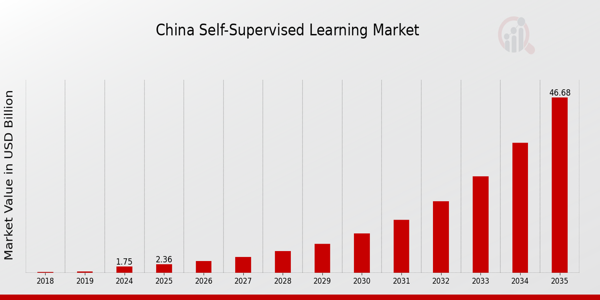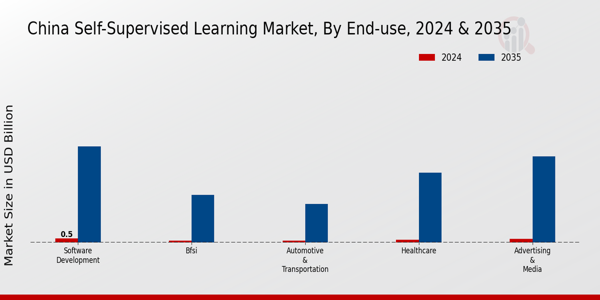China Self-Supervised Learning Market Overview
As per MRFR analysis, the China Self-Supervised Learning Market Size was estimated at 1.3 (USD Billion) in 2023. The China Self-Supervised Learning Market Industry is expected to grow from 1.75(USD Billion) in 2024 to 46.68 (USD Billion) by 2035. The China Self-Supervised Learning Market CAGR (growth rate) is expected to be around 34.786% during the forecast period (2025 - 2035)
Key China Self-Supervised Learning Market Trends Highlighted
China Self-Supervised Learning Market is expanding significantly due to the nation's rapid development of machine learning and artificial intelligence technologies. The Chinese government is investing heavily in AI, recognizing its potential to boost economic development and global competitiveness. As businesses look for more effective ways to train AI systems with unlabeled data, this encouraging approach encourages research and innovation in self-supervised learning. Furthermore, the need for self-supervised learning models that can efficiently use big datasets without requiring a lot of labeling is being driven by the growing emphasis on data privacy and the development of large datasets from a variety of industries, including healthcare and finance.
Opportunities abound in the China Self-Supervised Learning Market, especially in sectors like e-commerce, where companies want to improve consumer satisfaction by offering tailored recommendations. Additionally, self-supervised learning is in high demand as more businesses implement AI solutions in order to enhance decision-making and better understand customer behavior. China's growing smart city plans further aid the expansion of this market, since self-supervised learning can improve infrastructure management and urban data analysis. Chinese tech firms are concentrating on cooperative initiatives to develop self-supervised learning methods, according to recent trends.Universities and research organizations are increasingly collaborating on projects that result in new technical innovations.
Furthermore, there is a notable shift towards creating frameworks and tools that are more accessible for developers, as the need for talented AI professionals grows in the local market. All things considered, China is positioned as a key region in the development of self-supervised learning technologies due to the combination of government support, significant investment in AI, and the desire for creative applications.

Source: Primary Research, Secondary Research, MRFR Database and Analyst Review
China Self-Supervised Learning Market Drivers
Government Investment in Artificial Intelligence
The Chinese government has committed significant resources to advancing artificial intelligence technology, which is a critical element in the China Self-Supervised Learning Market Industry. As part of the 'New Generation Artificial Intelligence Development Plan', the Chinese central government has pledged to invest over 150 billion USD by 2030 to boost AI capabilities across the nation. This initiative is designed to place China at the forefront of global AI development, with a strong emphasis on self-supervised learning as a foundational technology that can enhance machine learning algorithms.
The backing from governmental institutions, along with growing allocations for research and development in educational and corporate sectors, is likely to propel the China Self-Supervised Learning Market. Moreover, industry leaders such as Baidu and Alibaba are aligning their Research and Development strategies to integrate self-supervised learning into their AI-driven products, thereby enhancing their competitiveness in the global market. The ambitious government plans are expected to spur innovation and attract talent, making it a vital driver of growth for the market in the coming years.
Rising Demand for Big Data Analytics
In China, the rapid growth of data generation, projected to reach 40 zettabytes by 2025 according to the Ministry of Industry and Information Technology, is creating an urgent need for advanced data analytics solutions. This is a primary driver for the China Self-Supervised Learning Market Industry, as self-supervised learning techniques enable models to leverage unlabelled data effectively, leading to more insightful analytics.
Major companies like Tencent are integrating self-supervised learning methodologies into their operations to improve customer insights and operational efficiency.Moreover, industries such as finance and healthcare are looking at self-supervised learning models to better analyze vast datasets without extensive human labeling, thus addressing the analytics gap and enhancing decision-making processes.
Surge in AI-Driven Startups
The landscape of technology in China is witnessing a monumental shift with the increase in AI-driven startups focusing on self-supervised learning technologies. In 2022, there were over 400 AI startups launched in China, many of which are innovating in the self-supervised learning domain. For instance, companies like Horizon Robotics are pioneering in this space, developing proprietary algorithms that minimize the need for labelled data.
This startup boom is not only attracting significant investments but also fostering a culture of innovation that is instrumental for the growth of the China Self-Supervised Learning Market Industry.Additionally, organizations such as the Chinese Academy of Sciences are providing vital support through mentorship and funding, creating a conducive environment for these startups to thrive.
China Self-Supervised Learning Market Segment Insights
Self-Supervised Learning Market End-use Insights
The China Self-Supervised Learning Market encompasses a diverse array of end-use applications that are paving the way for advancements across various sectors. In the healthcare industry, the application of self-supervised learning technologies has shown promising potential in areas like medical imaging and diagnostics, thus enhancing the ability to detect diseases early and improving patient outcomes. Meanwhile, the Banking, Financial Services and Insurance (BFSI) sector is adopting these technologies to bolster risk assessment, fraud detection, and customer relationship management, thereby streamlining operations and driving efficiency. The Automotive and Transportation segment is also significantly leveraging self-supervised learning for enhancing autonomous vehicle technologies and optimizing traffic management systems, contributing to increased safety and reduced congestion.
In the Software Development (Information Technology) realm, self-supervised learning methods are transforming how software can be developed and deployed, allowing for rapid adaptation to user needs through improved predictive analytics. The Advertising and Media sector adopts these technologies to personalize content delivery, enhancing consumer engagement through tailored advertising approaches, thereby optimizing marketing strategies to better reach targeted demographics. Besides these, other applications across various industries contribute to the overall growth and adoption of self-supervised learning technologies. These segments collectively highlight the importance and dominance of self-supervised learning, reflecting a shift towards data-driven decision-making in a rapidly evolving digital landscape.
As China furthers its commitment to innovation and technology, the involvement of self-supervised learning across these various end-use segments is expected to grow, fostering opportunities for advancement and efficiency across industries. This illustrates a significant trend towards harnessing artificial intelligence in ways that address specific industry challenges while providing transformative solutions aimed at enhancing operational capabilities. Overall, the diversity of applications across various sectors indicates a robust landscape for the China Self-Supervised Learning Market, driven by the demand for improved efficiency, accuracy, and effectiveness in data utilization.

Source: Primary Research, Secondary Research, MRFR Database and Analyst Review
Self-Supervised Learning Market Technology Insights
The China Self-Supervised Learning Market within the Technology segment has shown remarkable potential, highlighted by its rapid development across various applications. Natural Language Processing (NLP) plays a crucial role in enabling machines to understand and interact in human language, which is increasingly essential for chatbots, translation services, and sentiment analysis in online platforms. Computer Vision has gained momentum by assisting industries such as security, healthcare, and automotive in analyzing and interpreting visual data, enhancing user experiences and operational efficiencies.
Speech Processing, another significant area, is transforming communication systems by enabling voice recognition and synthesis technology, which is widely used in virtual assistants and automated customer service solutions. The intersection of these technologies is driving innovative applications, thereby increasing the overall adoption of self-supervised learning techniques in China. As the demand for more sophisticated artificial intelligence solutions continues to rise, the importance of these technological advancements will only grow, emphasizing their central role in shaping a robust digital landscape.
China Self-Supervised Learning Market Key Players and Competitive Insights
The China Self-Supervised Learning Market is experiencing significant growth as industries increasingly recognize the value of advanced machine learning techniques. This market is characterized by a rapid evolution of technology and methodologies that allow artificial intelligence models to learn from unlabelled data without the need for extensive human intervention. A competitive landscape has emerged, featuring both established academic institutions and leading tech companies that are leveraging their resources to innovate and enhance self-supervised learning capabilities. These players are not just competing for market share but are also at the forefront of research and development, pushing the boundaries of what self-supervised learning can achieve in areas such as natural language processing, computer vision, and data analysis.Peking University stands out as a prominent institution within the China Self-Supervised Learning Market due to its strong emphasis on cutting-edge research and innovation in artificial intelligence.
The university has been pivotal in advancing the academic understanding of self-supervised learning algorithms and their practical applications. Its robust research programs have facilitated partnerships with various industries, enhancing the applicability and effectiveness of self-supervised learning methods in real-world scenarios. With a dedicated faculty focusing on the latest AI developments and access to a wealth of resources, Peking University excels in cultivating talent and leading projects that contribute significantly to the advancement of self-supervised learning in China.iFlytek is another key player in the China Self-Supervised Learning Market, renowned for its linguistic and AI-driven solutions.
The company specializes in smart speech technology and natural language processing, employing self-supervised learning techniques to improve the accuracy and efficiency of its products. iFlytek has established a strong market presence across multiple sectors, including education, customer service, and healthcare. It is actively engaged in developing innovative products such as voice recognition systems and intelligent chatbots that leverage self-supervised learning to enhance user experiences. iFlytek has strategically pursued mergers and acquisitions to bolster its technology portfolio, further solidifying its position in the market. This proactive approach enables the company to integrate cutting-edge research into its offerings, thereby enhancing the effectiveness of its self-supervised learning implementations within China’s dynamic technological landscape.
Key Companies in the China Self-Supervised Learning Market Include
- Peking University
- iFlytek
- SenseTime
- Huawei
- ByteDance
- Ping An Technology
- Zhejiang University
- Tsinghua University
China Self-Supervised Learning Market Industry Developments
Recent developments in the China Self-Supervised Learning Market have showcased significant advancements and competitive dynamics among major players. Peking University and Tsinghua University have been at the forefront of innovative research projects in self-supervised learning frameworks, enhancing AI capabilities. In November 2023, Huawei announced an extension of its AI capabilities through enhanced self-supervised learning methodologies, aiming to boost its offerings in cloud computing and smart devices. Companies like Tencent and ByteDance are also increasingly investing in self-supervised learning to improve user experiences on their platforms, contributing to the market growth. iFlytek and SenseTime have released new models leveraging self-supervised techniques to optimize natural language processing and computer vision tasks.
In September 2023, Ping An Technology embarked on a strategic partnership with Alibaba to leverage self-supervised learning for improving healthcare AI solutions. The market has also seen a notable surge in valuation, attributed to the increasing demand for AI-driven solutions across various sectors in China, with projections suggesting exponential growth in the upcoming years. The emphasis on research and development within this domain is transforming products and services, making China a leading playground for advancements in self-supervised learning.
China Self-Supervised Learning Market Segmentation Insights
Self-Supervised Learning Market End-use Outlook
-
- Healthcare
- BFSI
- Automotive & Transportation
- Software Development (IT)
- Advertising & Media
- Others
Self-Supervised Learning Market Technology Outlook
-
- Natural Language Processing (NLP)
- Computer Vision
- Speech Processing
| Report Attribute/Metric Source: |
Details |
| MARKET SIZE 2023 |
1.3(USD Billion) |
| MARKET SIZE 2024 |
1.75(USD Billion) |
| MARKET SIZE 2035 |
46.68(USD Billion) |
| COMPOUND ANNUAL GROWTH RATE (CAGR) |
34.786% (2025 - 2035) |
| REPORT COVERAGE |
Revenue Forecast, Competitive Landscape, Growth Factors, and Trends |
| BASE YEAR |
2024 |
| MARKET FORECAST PERIOD |
2025 - 2035 |
| HISTORICAL DATA |
2019 - 2024 |
| MARKET FORECAST UNITS |
USD Billion |
| KEY COMPANIES PROFILED |
Peking University, iFlytek, SenseTime, Huawei, ByteDance, Ping An Technology, Zhejiang University, Tsinghua University, Alibaba, Megvii, DJI, Ant Group, Tencent, Baidu |
| SEGMENTS COVERED |
End-use, Technology |
| KEY MARKET OPPORTUNITIES |
Rapid AI adoption in industries, Increasing demand for data efficiency, Growth in natural language processing, Expanding cloud computing services, Rising investment in AI startups |
| KEY MARKET DYNAMICS |
increasing demand for AI applications, rapid advancements in NLP technologies, rise of big data analytics, government support for AI research, growing investment in machine learning |
| COUNTRIES COVERED |
China |
Frequently Asked Questions (FAQ):
The China Self-Supervised Learning Market is expected to be valued at 1.75 billion USD in 2024.
By 2035, the market is projected to reach a value of 46.68 billion USD.
The market is expected to grow at a CAGR of 34.786% from 2025 to 2035.
Significant sectors include Healthcare, BFSI, Automotive & Transportation, Software Development, and Advertising & Media.
The Healthcare sector is valued at 0.35 billion USD in 2024.
The BFSI sector is projected to reach a market value of 6.28 billion USD by 2035.
Major players include Peking University, iFlytek, SenseTime, Huawei, ByteDance, and Alibaba among others.
The Automotive & Transportation sector is expected to be valued at 5.1 billion USD by 2035.
The Software Development sector is anticipated to grow to 12.71 billion USD by 2035, reflecting strong opportunities.
The Advertising & Media sector is valued at 0.45 billion USD in 2024.
















